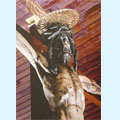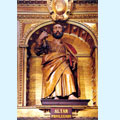SCULPTURE.
 This cultural manifestation did not acquire its own personality until the arrival of the baroque period, in which the region of Flanders occupied an outstanding place in the sculptural panorama of the Canary Islands, as well as other areas of the Old Continent.
This cultural manifestation did not acquire its own personality until the arrival of the baroque period, in which the region of Flanders occupied an outstanding place in the sculptural panorama of the Canary Islands, as well as other areas of the Old Continent.
At the beginning, the main works of art were made of wood; and cedar, due to its texture, became the most used, especially for creations related to the church, the largest commissioner of sculptures.
Sculpture did not achieve the same dimensions as did painting, but it occupies a prominent  place in the large cultural spectrum of the Canary archipelago, especially due to the historic value of its development.
place in the large cultural spectrum of the Canary archipelago, especially due to the historic value of its development.
Transcendental works, as well as less important pieces, can be appreciated anywhere in the islands, and this is possible thanks to the proliferation of good artists impregnated with the most varied tendencies whose productions have had various destinies, from the exclusive national middle class up to those that enrich the spiritual interests of museums, plazas and parks.